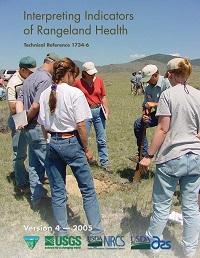Interpreting Indicators of Rangeland Health

Version 4 of Interpreting Indicators of Rangeland Health, Technical Reference 1734-6, is the second published edition of this technique. It follows the recommendations published in Pyke et al. (2002). The indicators are unchanged from Version 3, allowing this document to replace Version 3 even in areas where the evaluation process has already begun.
The changes in Version 4 are designed to improve the consistency in the application of the process. The most significant modification is the replacement of the Ecological Reference Area Worksheet with the Reference Sheet (Appendix 2). The Reference Sheet facilitates consistent application of the process on each ecological site by integrating all available sources of data and knowledge to generate a single range of reference conditions for each indicator. We have removed the Species Dominance Worksheet (Version 3, Appendix 4), since the information gained from this worksheet is similar to the information in the Functional/Structural Groups Sheet. We have included cells for noxious weeds and invasive plants in the Functional/Structural Groups Sheet (Version 4, Appendix 3). This allows users to continue to document the presence and abundance of invasive species for their records.
The Cover Sheet (Version 3, Appendix 3) has been deleted and information on collecting quantitative data is deferred to other publications. Based on a more thorough review of the literature, we have switched the attribute assignment for the litter movement indicator from Hydrologic Function to Soil/Site Stability in Version 4, Appendix 1. In Version 3, Appendix 1, all of the indicator rating categories except “Extreme departure from the Ecological Site Description/Reference Area” implied that the category included a range of values. This implication came either from the title (for example None to Slight departure) or from the position within the range of the other categories (for example Moderate was between Slight to Moderate and Moderate to Extreme), but the fifth category, Extreme, caused some users to believe that this category did not include a range, but was the absolute worst departure possible. This was not our intention and we have changed the Extreme category to Extreme to Total in Version 4, Appendix 1.
We strongly recommend that the indicator descriptors in the Evaluation Matrix in Version 4, Appendix 4, for each ecological site be revised and made more specific. This change has been designed to improve consistency among observers. The wording of the “default descriptors" has been retained as “generic descriptors” in nearly all cases. Only minor changes were made to the generic descriptors. These changes clarify the indicators and do not change their interpretation.
In other words, interpretations made with Version 3 will be consistent with those made with Version 4 provided that the same reference information is used. A flow chart under the “Instructions for Using the Rangeland Health Assessment Protocol” section and the Checklist for Rangeland Health Assessment Protocol, Appendix 8, were added to help ensure that all the necessary steps are completed. Finally, we have added new information, “Quantitative Measures for the 17 Indicators” (Appendix 6), that describes quantitative methods that can be used to generate data to complement this qualitative assessment process.
